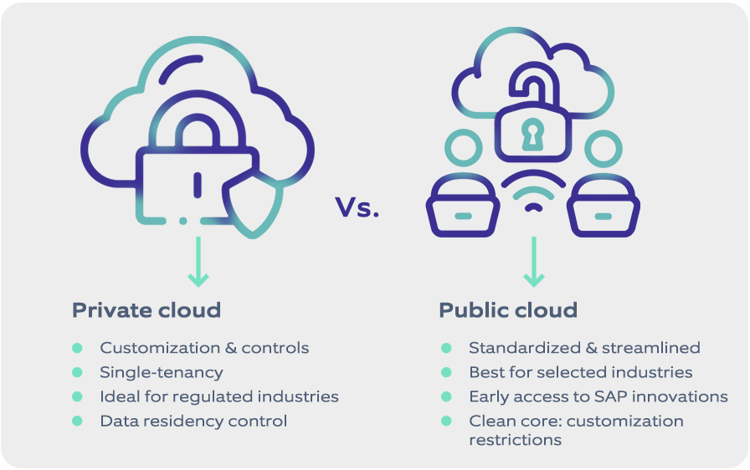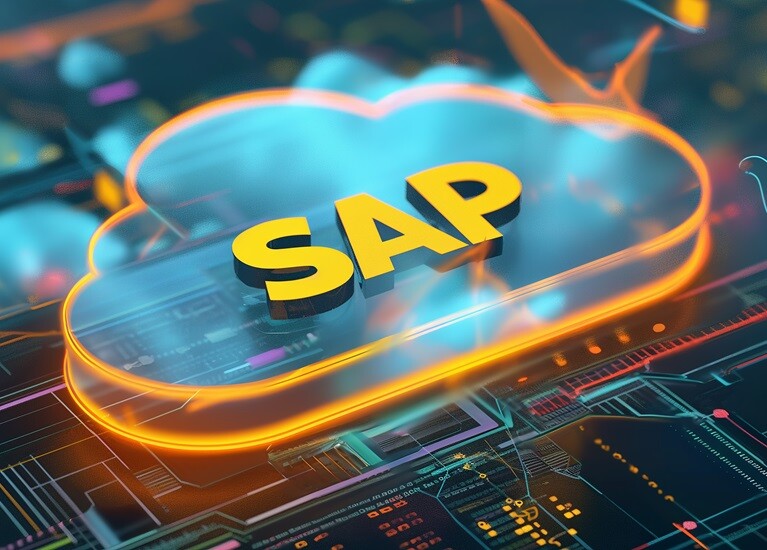As SAP customers navigate the company's cloud-first strategy, they are faced with important decisions about how their ERP systems should be deployed in the cloud landscape. With the emphasis on S/4HANA, SAP has rolled out two distinct cloud models—public and private—that serve different needs, depending on industry, operational scale, and regulatory requirements. But how can businesses confidently choose the model that best aligns with their goals?
In this blog, we explore the motivations behind SAP's cloud strategy, offer insights on public and private cloud, and examine real-world factors that inform a smooth transition.
Why the shift to cloud?
SAP's move to a cloud-first approach is driven not just by technology, but by the need to enable scalable, secure growth for businesses. A key factor is that SAP's legacy ECC system, which many customers still use, is over 19 years old and based on outdated technology. In the fast-paced world of IT, new innovations like AI capabilities have emerged that are simply not possible to build on the aging ECC stack.
While ECC systems are not inherently bad or outdated, SAP recognizes that customers who want to take advantage of modern innovations like the Joule AI assistant will need to migrate to the newer S/4HANA platform, which is available in both public and private cloud versions. Since 2020, SAP has been actively transitioning its customer base to these cloud-based ERP solutions, phasing out significant investment in on-premises options.
This shift can feel abrupt for SAP's long-standing on-premises customers. However, SAP is acknowledging this urgency by continuing to support both the public and private cloud deployment models, enabling customers to choose the approach that best fits their specific needs and constraints.
SAP’s journey from ECC to S/4HANA: A legacy evolved
SAP's ERP journey has spanned multiple transformative generations, from the early R/1 and R/2 systems to the widely adopted R/3 and ECC platforms. The latest, S/4HANA, represents a significant leap forward, offering clients the agility, speed, and insights needed to thrive in today's interconnected markets.
A key advantage of S/4HANA is its seamless integration across both public and private cloud environments, making it a pivotal part of SAP's commitment to empowering organizations with smarter, faster, and more flexible ERP capabilities. This cloud-native architecture allows customers to choose the deployment model that best suits their business needs, whether that's the standardized, scalable public cloud or the highly customizable private cloud.
Defining public vs. private cloud for SAP S/4HANA
SAP offers two cloud deployment models, each serving distinct needs and operating styles:
Public cloud: Standardized and streamlined
- Multi-tenant, SaaS model: SAP’s public cloud operates on a multi-tenant model, ideal for businesses aiming to simplify and standardize processes. The SaaS delivery makes it easy for customers to work with a system out of the box. There is less internal IT (not zero, of course) resources needed for the maintenance of the ERP, as this is handled by SAP.
- Best for selected industries and finance-led projects: Public cloud works well for finance, professional services, component manufacturing and sectors where efficiency and consistency are key.
- Early innovation access: The standardized data model allows public cloud users early access to SAP's latest innovations, from AI tools to real-time analytics. SAP says all innovations come to the public cloud edition first, such as their AI copilot Joule which is only available in the public cloud as of now.
- Customization limitations: To maintain a ‘clean core’, SAP’s public cloud restricts deep customizations, with additional extensibility options through BTP. When the standard is not enough or a customer needs a functionality that is not within the scope, we can build this with BTP and the extensibility framework.
Private cloud: Customization and control
- Single-tenant flexibility: Designed for organizations needing highly customized setups, private cloud supports deeper tailoring of ERP processes.
- Ideal for regulated industries: Private cloud’s flexibility suits industries like life sciences and manufacturing, where compliance requirements demand unique configurations.
- Data residency control: With a sophisticated framework of security, compliance, data protection and privacy, and security and sovereignty options, SAP offers a strong cloud portfolio.

Tailored programs for your cloud transition: RISE with SAP and GROW with SAP
It’s also important to also consider RISE with SAP and GROW with SAP—two distinct programs designed to facilitate the successful migration to SAP S/4HANA in the cloud.
- GROW with SAP: This program focuses on public cloud deployment and enables a SaaS approach that simplifies integration, reduces implementation time, and accelerates adoption. It’s an ideal solution for fast-growing SMEs looking for a streamlined, cost-effective path to digital transformation.
- RISE with SAP: On the other hand, RISE with SAP is centered around private cloud deployment and offers a more personalized, flexible approach. It is designed to meet the complex needs of large enterprises, enabling them to maintain control over their infrastructure, processes, and customization.
Key considerations when choosing your SAP cloud path
a. Industry fit and functionality needs
For organizations operating with standardized processes, the public cloud's scalable environment and shared innovation model can deliver efficiency and faster time-to-value. In contrast, sectors with rigorous regulatory demands-such as healthcare, pharmaceuticals, often require the deeper customization and flexibility available in a single-tenant environment.
b. Localization compliance
Local versions help you meet local requirements by considering diverse legal frameworks, and different languages, and by complying with a wide range of local financial reporting standards, tax calculations and laws. Localization varies while public cloud is localized for 59 countries and 32 languages, the private option is localized for 63 countries and 39 languages.
c. Cost and contractual considerations
Both deployment models shift costs from CapEx to OpEx, though multi-tenant environments offer an all-in-one subscription model for simpler billing, whereas single-tenant setups may include initial licensing fees in addition to recurring costs. For existing SAP clients, migration may require revisiting current contract terms and assessing any available rebates as part of the transition.
d. Scalability and access to innovation
While both deployment options, public and private, offer scalability, access to innovation is faster with the public cloud, since SAP pledged to have all the innovation in the public cloud first (as seen with Joule). Another difference is the update cycle, while on the private cloud (depending on whether this is bought within RISE or as a product), customers have a yearly update, while public cloud users have two mandatory and fixed updates (in February and August) that will be uploaded by SAP directly into the system.

The migration journey: Overcoming challenges
Transitioning ERP systems to the cloud requires a thoughtful approach. For long-time SAP users, adapting to a cloud-based interface can seem daunting. Implementation partners offer valuable support in managing this transition, equipping teams to navigate the new landscape with confidence. Beyond the technical changes, partners provide insight into adoption strategies, mitigating resistance and guiding successful change management.
Multi-cloud options and migration tools
For businesses seeking greater flexibility, SAP’s multi-cloud support allows for hosting on major hyperscalers such as AWS, GCP, Alibaba, Azure, and other local vendors although multi-cloud capabilities remain limited. Migration tools like SAP’s Digital Discovery Assessment (DDA), Signavio for process mapping, and LeanIX for enterprise architecture management offer organizations critical insights for assessing readiness and planning their journey.
Future direction: Public cloud innovation and private cloud stability
As SAP continues to enhance its public cloud offerings, the private cloud will remain essential for industries needing tailored, industry-specific capabilities. By keeping both paths viable, SAP enables organizations across sectors to build forward-looking, adaptable ERP ecosystems that support their unique missions.
Best practices for deciding on a cloud model
Making the choice between SAP’s public and private cloud options is nuanced. For organizations weighing these paths, here are some best practices:
- Evaluate industry needs: Look at whether standardized or customized processes fit your industry’s requirements.
- Assess localization requirements: Ensure that localization capabilities align with your operational footprint.
- Engage with experts: Rely on implementation partners for insights, especially for complex customizations.
- Leverage migration tools: Tools like DDA and Signavio provide clarity and structure in the migration process.
Closing thoughts: Charting the right cloud course with SAP
For organizations charting their future with SAP, cloud deployment isn’t one-size-fits-all. While the public cloud offers standardized, rapid-deployment efficiency, the private cloud serves businesses that need sophisticated customization. By understanding these models and aligning them with industry demands, organizations can embark on their cloud journey with confidence—backed by insights, partners, and tools that make the transition smoother and the future brighter.






